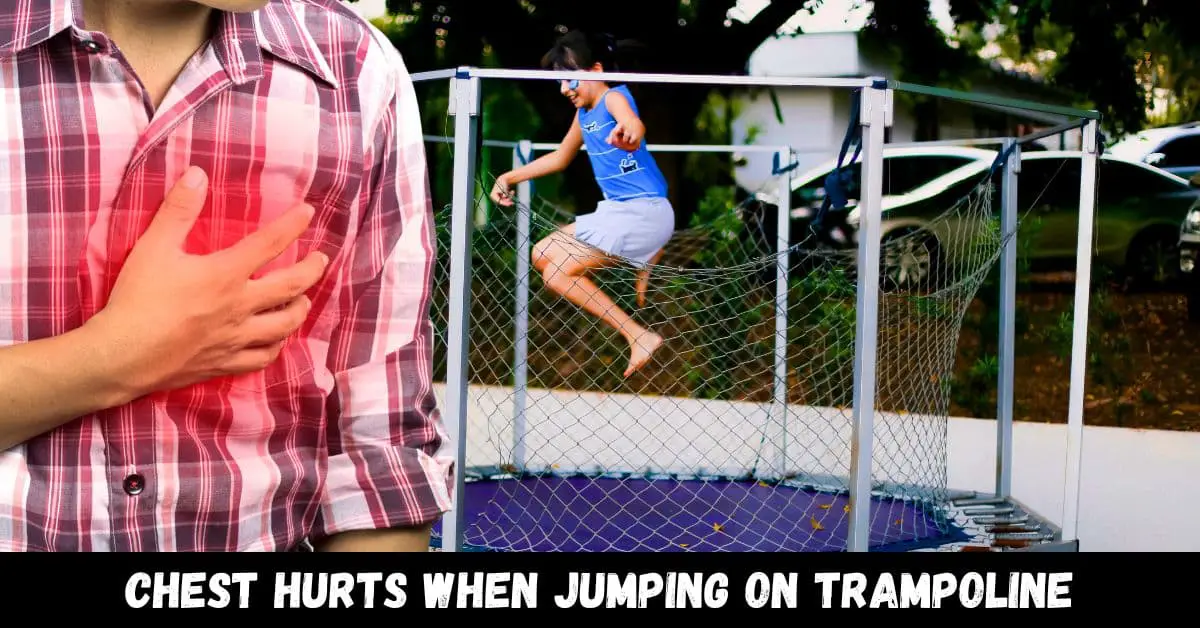I was excited and excited when I first started jumping on a trampoline. However, after a few minutes of bouncing, I felt a sharp pain in my chest.
It was a discomfort I had never experienced before, making me feel worried and confused. Despite the pain, I continued to jump, thinking it might just be a temporary discomfort.
However, the pain persisted and even got worse. I began to feel anxious and wondered if I was doing something wrong. I couldn’t understand why my chest was hurting, as I had no prior health issues related to my heart or lungs.
It wasn’t until I did some research that I realized that chest pain while jumping on a trampoline is common and can be caused by various factors.
Understanding the potential causes and taking preventative measures can help alleviate this discomfort and ensure that trampolining remains safe and enjoyable.
Chest hurts when jumping on trampoline: Chest pain while jumping on a trampoline could be due to muscle strain, poor posture, or underlying medical conditions. If severe or persistent, consult a healthcare professional for evaluation.
Chest Hurts When Jumping On Trampoline?
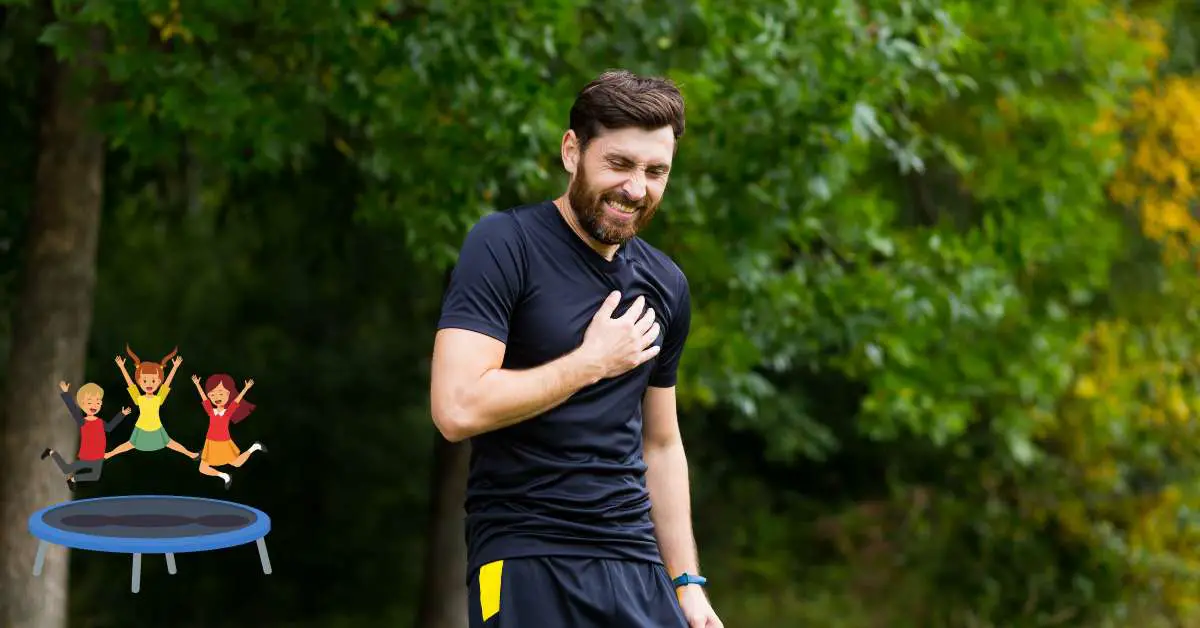
If you experience chest pain when jumping on a trampoline, it is important to stop jumping immediately and seek medical attention. Chest pain can be a sign of a serious injury or medical condition, such as a broken rib, a strained muscle, or even a heart problem.
While waiting for medical attention, try to stay calm and avoid any further movement that could aggravate the pain. Applying ice to the affected area may also help reduce swelling and discomfort.
To prevent chest pain and other injuries when jumping on a trampoline, be sure to follow proper jumping techniques and safety guidelines, including:
- Always warm up before jumping and stretch your muscles.
- Avoid doing risky maneuvers, such as flips or somersaults, unless you are properly trained and supervised.
- Wear appropriate clothing and footwear, such as athletic shoes with good traction and supportive sports bras for females.
- Make sure the trampoline is properly assembled, secured, and maintained, with no tears or worn spots on the mat or springs.
- Do not allow multiple jumpers at the same time, as collisions and falls can easily occur.
Remember, trampolining can be a fun and healthy activity, but it can also pose risks if not done safely. Always use caution and common sense, and seek medical attention if you experience any pain or discomfort while jumping.
Chest Pain when jumping

Trampolines have become increasingly popular as a recreational activity for people of all ages. They provide a fun and exciting way to engage in physical exercise and can be found in many backyards, parks, and trampoline parks.
However, being aware of potential risks and health concerns associated with trampoline use is important. One such concern is experiencing chest pain while jumping on a trampoline. This essay aims to explore this issue, its potential causes, and the importance of understanding them.
Understanding the potential causes of chest pain while jumping on a trampoline:
Chest pain is a symptom that should never be taken lightly. While trampolines are generally considered safe, incidents of chest pain during trampoline use have been reported. Understanding the potential causes of this chest pain is crucial for several reasons.
Firstly, it allows individuals to identify whether their chest pain results from trampoline-related activities or if there may be an underlying medical condition.
Chest pain can be a symptom of various health issues, including cardiovascular problems, musculoskeletal injuries, or respiratory conditions. By understanding the potential causes, individuals can better evaluate their symptoms and seek appropriate medical advice.
Secondly, understanding the causes of chest pain while jumping on a trampoline enables individuals to take necessary precautions and make informed decisions about their usage.
It helps determine whether adjustments in jumping intensity, modifications in jumping techniques, or alternative forms of exercise on the trampoline are necessary to avoid or minimize chest pain.
Following main points
This essay will delve into the potential causes of chest pain while jumping on a trampoline, covering three main areas: musculoskeletal causes, impact or trauma, and pre-existing health conditions.
In the section on musculoskeletal causes, the essay will explore how overexertion of chest muscles, strain or inflammation of intercostal muscles, and rib bruising or costochondritis can contribute to chest pain.
The impact of trauma section will discuss how sudden jarring or landing incorrectly on the trampoline and direct impact to the chest from collisions with other jumpers or the trampoline frame can lead to chest pain.
The essay will also address the role of pre-existing health conditions, such as asthma or other respiratory conditions, as well as cardiovascular issues like angina or heart arrhythmias, in exacerbating chest pain during trampoline use.
Furthermore, the essay will provide recommendations and precautions for individuals experiencing chest pain while jumping on a trampoline.
This will include seeking medical consultation, modifying trampoline activities, incorporating warm-up and stretching exercises, and implementing safety precautions.
Common Causes of Chest Pain While Jumping on a Trampoline
Jumping on a trampoline can be a fun and exhilarating activity for people of all ages. However, it can also come with risks, including chest pain. Chest pain while trampolining can be caused by a number of different factors, including physical trauma, musculoskeletal pain, and cardiovascular issues.
Physical Trauma
Physical trauma is a common cause of chest pain while jumping on a trampoline. When a person jumps on a trampoline, they are at risk of falling or colliding with others, which can cause injuries resulting in chest pain.
Sometimes, a person may even land awkwardly on the trampoline mat, leading to chest pain. Some examples of physical trauma that can occur while jumping on a trampoline include:
Rib fractures: When a person falls on the trampoline, they can fracture or break one or more ribs. This can cause sharp chest pain, difficulty breathing, and tenderness when touching the affected area.
Chest contusions: A chest contusion is a bruise that forms on the chest after a blow or impact. When a person collides with another person or lands awkwardly on the trampoline mat, they may experience a chest contusion, which can cause pain, tenderness, and swelling in the affected area.
Punctured lung: In rare cases, a person may experience a punctured lung while jumping on a trampoline. This can occur when a rib fractures and punctures the lung, causing chest pain, difficulty breathing, and other serious symptoms.
Musculoskeletal Pain
Musculoskeletal pain is another common cause of chest pain while jumping on a trampoline. The repetitive bouncing and landing motions of trampolining can cause strain and stress on the muscles, tendons, and ligaments in the chest area, leading to pain and discomfort.
Some examples of musculoskeletal pain that can occur while jumping on a trampoline include:
Muscle strain: When the muscles in the chest are overworked or overstretched, they can become strained, leading to pain, tenderness, and limited mobility.
Tendonitis: Tendonitis is an inflammation of the tendons that connect muscles to bones. When the tendons in the chest area are repeatedly stressed during trampolining, they can become inflamed, causing pain and discomfort.
Costochondritis: Costochondritis is an inflammation of the cartilage that connects the ribs to the sternum. This condition can cause chest pain, tenderness, and swelling, especially during repetitive activities like trampolining.
Cardiovascular Issues
While less common than physical trauma and musculoskeletal pain, cardiovascular issues can lead to chest pain while jumping on a trampoline. Trampolining is a physically demanding activity that requires a significant amount of cardiovascular endurance.
Suppose a person has an underlying cardiovascular condition, such as heart disease or high blood pressure. In that case, they may have a higher risk of experiencing chest pain while jumping on a trampoline.
Some examples of cardiovascular issues that can occur while jumping on a trampoline include:
Angina: Angina is chest pain when the heart does not receive enough oxygen. This can be caused by a blockage in the arteries that supply blood to the heart. If a person with angina engages in physically demanding activities, such as trampolining, they may experience chest pain or discomfort.
Arrhythmia: Arrhythmia is an abnormal heart rhythm that can cause various symptoms, including chest pain, shortness of breath, and dizziness. If a person has an underlying arrhythmia and engages in trampolining, they may be at risk of experiencing chest pain or other symptoms.
External and Internal Causes of Chest Pain
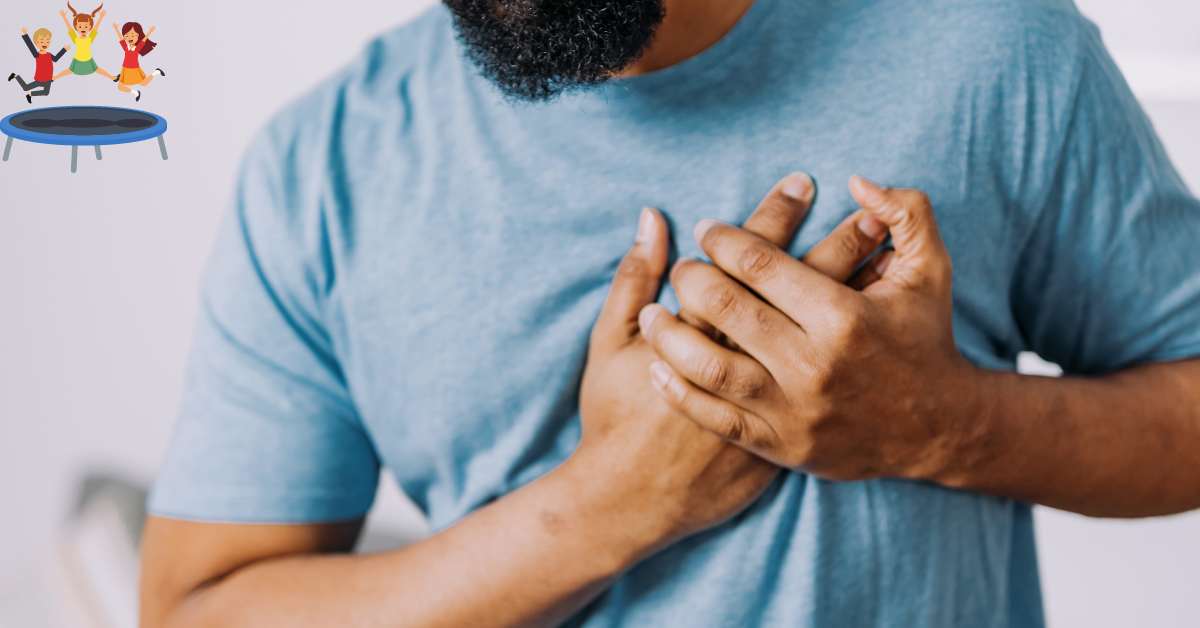
Chest pain can be a concerning symptom, especially during physical activity. Understanding the different causes of chest pain is essential to determine the appropriate course of action. Various external and internal factors can cause chest pain.
External factors include environmental conditions such as cold weather, allergies, and pollution, while internal factors can include exercise-induced bronchoconstriction (EIB). we will discuss the external and internal causes of chest pain and how to manage them.
External Causes:
Cold weather, allergies, and pollution are external factors that can trigger chest pain during physical activity. Cold weather causes the airways to constrict, making it harder to breathe, which can lead to chest pain.
Allergies, such as pollen or dust, can cause inflammation in the airways, resulting in chest tightness or pain. Pollution from smoke or exhaust fumes can also irritate the lungs, leading to chest pain.
To prevent chest pain caused by external factors, it’s essential to take proper precautions. In cold weather, dress warmly and cover your mouth and nose with a scarf to protect against the elements.
Avoiding known allergens and pollution sources can also help reduce the risk of chest pain. If you experience chest pain due to these external factors, taking a break and finding a warmer or cleaner environment can help alleviate symptoms.
Internal Causes:
Exercise-induced bronchoconstriction (EIB) is a common internal cause of chest pain during physical activity. EIB is a narrowing of the airways that makes breathing difficult, and it’s often caused by physical activity in cold weather or exposure to allergens or pollution.
People with asthma are especially susceptible to EIB, but even those without asthma can experience this condition.
To prevent and manage EIB, it’s essential to warm up slowly before engaging in strenuous physical activity. A slow warm-up gives your body time to adjust and prevents sudden changes in temperature or humidity that can trigger an attack.
Using an inhaler before exercising can also help open up the airways and prevent symptoms of EIB. Staying hydrated by drinking plenty of fluids before and during exercise is also essential.
Prevention and Treatment of Chest Pain While Jumping on a Trampoline
While chest pain can be a common occurrence while jumping on a trampoline, some steps can be taken to prevent it from happening. If chest pain does occur, there are also various treatment options available.
This section will discuss the prevention and treatment of chest pain while jumping on a trampoline.
Prevention
Preventing chest pain while jumping on a trampoline is essential to ensure a safe and enjoyable experience. The following are three important preventative measures that can help reduce the risk of chest pain:
Proper warm-up and stretching
One of the best ways to prevent chest pain while jumping on a trampoline is to warm up before beginning vigorous physical activity. This can include light aerobic exercises, such as jogging in place or jumping jacks, and stretching exercises targeting the chest muscles.
Stretching can help to increase flexibility and range of motion, which can help to reduce the risk of injury and chest pain.
Safe trampoline use
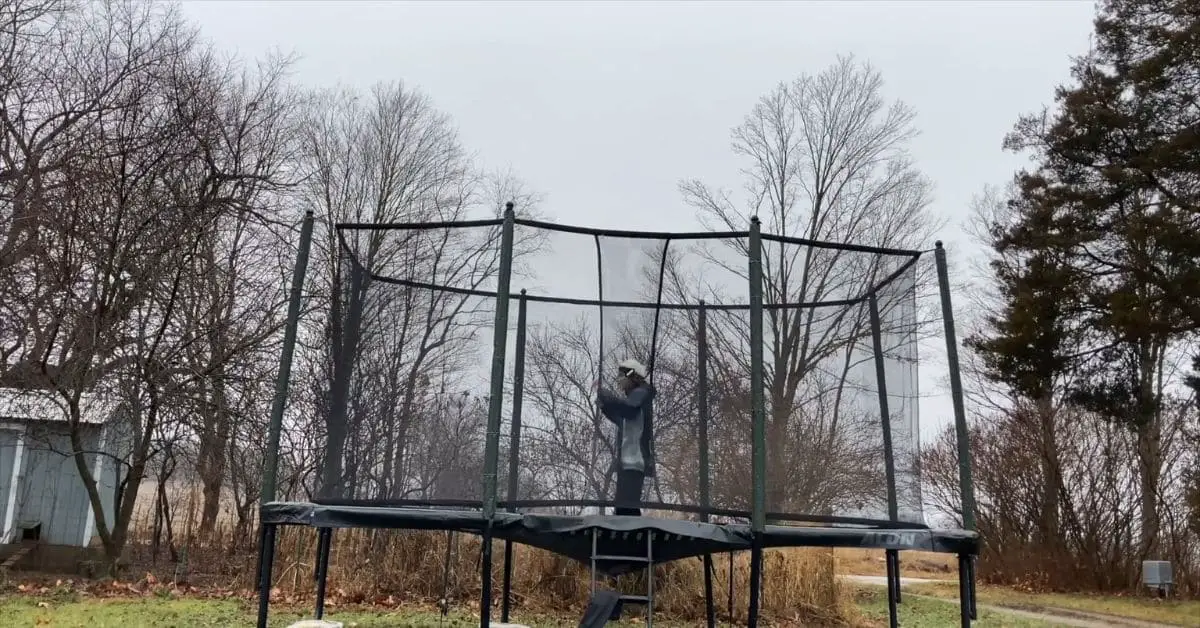
To prevent chest pain while jumping on a trampoline, it is important to use the trampoline safely and responsibly.
This means following all safety guidelines, such as not allowing more than one person to jump at a time and avoiding risky maneuvers, such as flips and somersaults.
It is also important to ensure the trampoline is in good condition, with no tears or worn areas in the mat or springs.
Proper landing techniques
Another important way to prevent chest pain while jumping on a trampoline is to use proper landing techniques. This means landing with both feet together, keeping the knees bent, and landing on the balls of the feet rather than the heels.
This can help to absorb the shock of landing and reduce the stress on the chest muscles.
Treatment
If chest pain occurs while jumping on a trampoline, the following treatment measures can be taken:
Rest and recovery
If chest pain does occur while jumping on a trampoline, it is important to rest and allow the body time to recover. This may involve taking a break from trampolining or other physical activity until the pain subsides. Rest can help to reduce inflammation and allow the body to heal.
Pain management strategies
Various pain management strategies can be used to alleviate chest pain while jumping on a trampoline. These can include applying ice to the affected area, taking over-the-counter pain medication such as acetaminophen or ibuprofen, and using topical creams or ointments to reduce inflammation and pain.
Seeking medical attention if necessary
Sometimes, chest pain while jumping on a trampoline may require medical attention. If the pain is severe or does not improve with rest and pain management strategies, it is important to seek medical advice.
This may involve visiting a doctor or healthcare provider who can assess the extent of the injury and recommend appropriate treatment.
Benefits of Trampolining
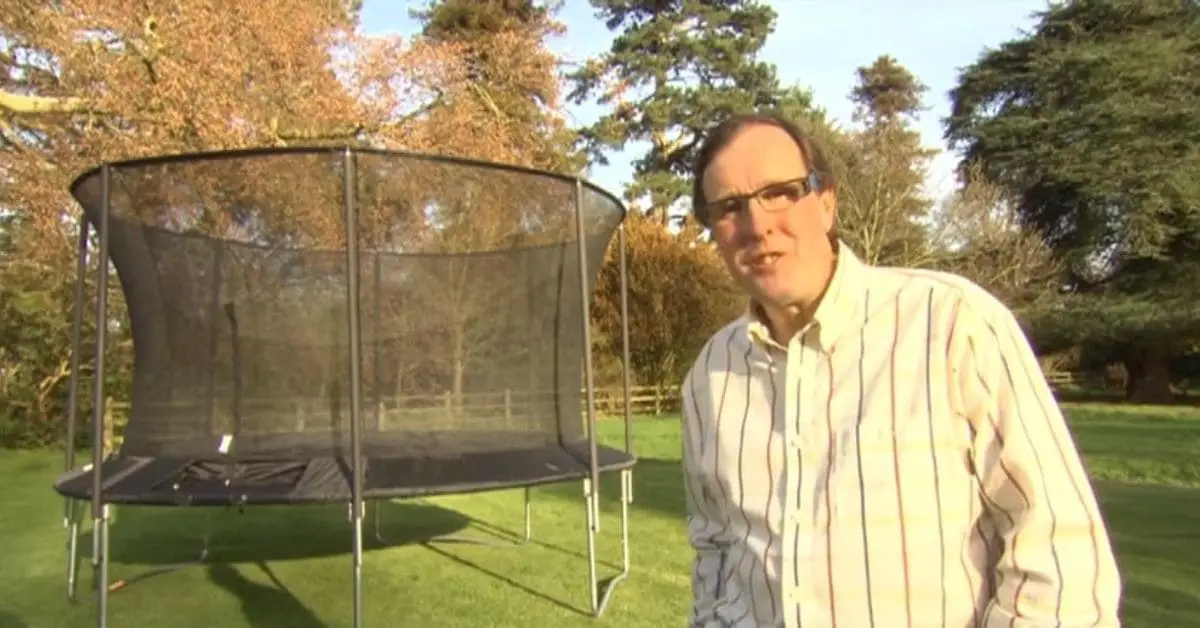
Trampolining is not only a fun activity but also offers numerous health benefits. Here are some of the benefits of trampolining:
Improved Body System:
Trampolining can help improve your cardiovascular system, which is responsible for transporting oxygen and nutrients throughout your body. As you jump on the trampoline, your heart rate increases, and your lungs work harder to supply oxygen to your body.
This increased blood flow can also help improve your immune system, promoting overall health.
Burns Crazy Calories:
Trampolining is a great way to burn calories and lose weight. According to studies, an hour of jumping on a trampoline can burn up to 500 calories. This is because trampolining involves multiple muscle groups and requires a lot of energy.
Diseases that Trampolining Fights:
Trampolining has been shown to help fight diseases such as diabetes, obesity, and heart disease. This is because trampolining can help regulate blood sugar levels and improve blood pressure, both of which are key factors in preventing these diseases.
Improved Balance and Coordination:
Trampolining requires a lot of balance and coordination, and practicing on a trampoline can help improve these skills. This can especially benefit older adults at risk of falls and injuries.
Low-Impact Exercise:
Unlike other forms of exercise, such as running or jumping rope, trampolining is low-impact and easier on your joints. This makes it a great exercise option for joint pain or arthritis.
Stress Relief:
Jumping on a trampoline can also be a great way to relieve stress and improve your mood. Jumping releases endorphins, natural chemicals in the body that help improve mood and reduce stress levels.
Fun for the Whole Family:
Trampolining is a fun activity that the whole family can enjoy. It’s a great way to get everyone up and moving, and it’s a fun way to bond and create memories.
Understanding Chest Pain During Physical Activity?
Sometimes when you exercise, you might feel pain in your chest. This is called exercise-induced bronchoconstriction or EIB. It happens when your airways get smaller, making breathing hard. Cold weather, allergies, or pollution can cause EIB.
People who have asthma are more likely to get EIB. Symptoms of EIB include shortness of breath, wheezing, coughing, and chest pain.
If you have asthma, you can use an inhaler before exercising to prevent EIB. Even if you don’t have asthma, there are things you can do to prevent and treat EIB. For example, warm up slowly before exercising to give your body time to adjust.
Dress warmly if it’s cold outside and avoid known triggers such as pollen or smoke. Drink plenty of fluids before and during exercise to stay hydrated. These tips can help you avoid chest pain and breathe easier during physical activity.
Understanding Seriousness of Chest Pain?
If you feel pain in your chest, you should check if it hurts a lot or a little if it comes and goes, and if the pain spreads to your back, jaw, or arm. These are important things to think about when deciding if your chest pain is serious.
Different things can cause chest pain, and some of them are not so bad. For example, heartburn or indigestion can cause chest pain.
But if you also feel short of breath, sweat, dizzy, or have nausea, it might be a sign of a more serious problem, like a heart attack. If you’re not sure if your chest pain is serious, it’s better to be safe and get medical help. If you think you might be having a heart attack, call 911 right away.
FAQs
Q.1 Why does my chest hurt when I jump on a trampoline?
When you jump on a trampoline, your body experiences a sudden jolt. This jolt can cause your chest muscles to contract forcefully, leading to chest pain. Additionally, jumping on a trampoline can also cause air to be trapped in your chest, leading to discomfort and pain.
Q.2 Is chest pain when jumping on a trampoline a cause for concern?
It depends on the severity and duration of the pain. Mild discomfort is common when jumping on a trampoline and usually subsides quickly.
However, if the pain is severe, persists, or is accompanied by other symptoms such as shortness of breath, dizziness, or nausea, you should seek medical attention immediately.
Q.3 How can I prevent chest pain when jumping on a trampoline?
One way to prevent chest pain when jumping on a trampoline is to warm up properly before jumping. This can include light stretching, jumping jacks, or jogging in place.
You should also ensure you’re using the trampoline correctly and not overexert yourself. Avoid jumping too high or for extended periods, and take breaks if you start to feel fatigued.
Q.4 What should I do if I experience chest pain when jumping on a trampoline?
If you experience chest pain when jumping on a trampoline, stop immediately and rest. Take deep breaths and try to relax your chest muscles.
If the pain persists, take a break from jumping and apply a cold compress to the affected area. If the pain is severe or accompanied by other symptoms, seek medical attention immediately.
Q.5 Are there any underlying conditions that can cause chest pain when jumping on a trampoline?
Chest pain when jumping on a trampoline can be a symptom of an underlying condition such as asthma, a heart condition, or a musculoskeletal problem.
If you experience chest pain regularly when jumping on a trampoline, it’s a good idea to talk to your doctor to rule out any underlying medical issues.
Conclusion
In conclusion, chest pain while jumping on a trampoline can be caused by physical trauma, musculoskeletal pain, or cardiovascular issues. External causes, such as improper landing techniques, and internal causes, such as pre-existing medical conditions, may also contribute to chest pain.
Proper warm-up and stretching, safe trampoline use, and proper landing techniques are recommended to prevent chest pain. In chest pain, rest, pain management strategies, and seeking medical attention may be necessary.
Despite the potential risks, trampolining has several benefits, including improved body systems, burning calories, fighting diseases, improved balance and coordination, and stress relief.
It is important to understand the seriousness of chest pain during physical activity and seek medical attention if necessary.
We hope that this detailed guide on chest hurts when jumping on trampoline has helped you understand the topic better. If you have any questions, please ask them by commenting below.

